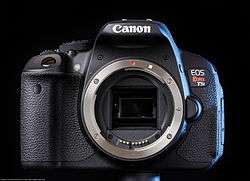Canon EOS 700D
 | |
| Overview | |
|---|---|
| Type | Digital single-lens reflex camera |
| Lens | |
| Lens | Interchangeable (EF / EF-S) |
| Sensor/Medium | |
| Image sensor type | CMOS |
| Image sensor size | 22.3 × 14.9 mm (APS-C format) |
| Maximum resolution | 5184 × 3456 (18.0 effective megapixels) |
| ASA/ISO range | 100 – 12800 (expandable to H: 25600) |
| Storage | SD/SDHC/SDXC (UHS-I bus supported) |
| Focusing | |
| Focus modes | One-Shot, AI Focus, AI Servo, Live View (FlexiZone - Multi, FlexiZone - Single, Face Detection), Movie Servo |
| Focus areas | 9 cross-type AF points |
| Exposure/Metering | |
| Exposure modes | Scene Intelligent Auto, Flash Off, Creative Auto, Portrait, Landscape, Close-up, Sports, Special Scenes (Night Portrait, Handheld Night Scene, HDR Backlight Control), Program AE, Shutter priority AE, Aperture priority AE, Manual exposure, Movie |
| Exposure metering | Full aperture TTL, 63 zones iFCL SPC |
| Metering modes | Evaluative, Partial, Spot, Center-weighted average |
| Flash | |
| Flash | E-TTL II auto-pop-up built-in / External |
| Flash bracketing | Yes |
| Shutter | |
| Shutter | Electronic focal-plane |
| Shutter speed range | 1/4000 sec. - 30 sec. and Bulb; X-sync at 1/200 sec. |
| Continuous shooting | 5.0 fps for 22 JPEG (30 with UHS-I cards) or for 6 RAW frames |
| Viewfinder | |
| Viewfinder | Eye-level pentamirror with 95% coverage and 0.85x magnification / LCD (Live View) |
| Image Processing | |
| Image processor | DIGIC 5 |
| Custom WB | Auto, Daylight, Shade, Cloudy, Tungsten, White Fluorescent, Flash, Custom |
| WB bracketing | +/- 3 stops for 3 frames |
| General | |
| Rear LCD monitor | 3.0" (7.7 cm) Clear View II colour TFT LCD touchscreen with 1,040,000 dots resolution |
| Battery | LP-E8 Li-Ion rechargeable |
| Optional battery packs | BG-E8 grip allows the use one LP-E8 battery or two LP-E8 batteries |
| Dimensions | 133.1 mm × 99.5 mm × 79.7 mm (5.24 in × 3.92 in × 3.14 in) |
| Weight | 525 g (18.5 oz) (body only) |
| Made in | Taiwan / Japan |
The Canon EOS 700D, known as the Kiss X7i in Japan or as the Rebel T5i in the Americas, is an 18.0 megapixel digital single-lens reflex camera made by Canon. It was announced on March 21, 2013 with a suggested retail price of US$849. As a part of the Canon EOS three-digit/Rebel digital line, it is the successor to the EOS 650D/Kiss X6i/Rebel T4i and is the predecessor of both the EOS 750D/Kiss X8i/Rebel T6i and EOS 760D/EOS 8000D/Rebel T6s.
Features
The 700D has a feature set almost identical to that of the older 650D. According to photographer and technology writer Gordon Laing,
It's fair to say that not a great deal has changed between the T5i / 700D and its predecessor. Indeed they're identical other than three changes: a new mode dial which can rotate through 360 degrees and keep turning, previews of Creative Filters in Live View, and a new external coating inherited from mid-range models like the 60D to provide a more durable finish.[1]
The 700D, however, was introduced with a new kit lens — a new version of the existing EF-S 18–55mm that employs Canon's STM (stepping motor) technology. It also (for the first time in a Canon 18–55mm lens) has a front section that does not rotate.[1]
Features include:
- 18.0 effective megapixel APS-C CMOS sensor (Hybrid CMOS sensor)
- 9 AF points, all cross-type at f/5.6. Center point is high precision, double cross-type at f/2.8 or faster
- DIGIC 5 image processor with 14-bit processing
- ISO 100 – 12800 sensitivity, extends to ISO 25600
- 95% viewfinder frame coverage with 0.85x magnification
- 1080p full HD video recording at 30fps, 25p (25 Hz) and 30p (29.97 Hz) with drop frame timing
- 720p HD video recording at 60p (59.94 Hz) and 50p (50 Hz)
- 480p ED video recording at 30p and 25p
- 5.0 frames per second continuous shooting
- 3.0-inch Vari-angle Clear View LCD II Touch screen with 1.04-megapixel resolution
- 3.5 mm microphone jack for external microphones or recorders
Differences compared to EOS 650D:
- Real-time preview of Creative Filters in Live View mode
- Redesigned new mode dial that can rotate 360 degrees
- New "upmarket" textured body finish
References
- 1 2 Laing, Gordon (March 2013). "Canon Rebel T5i / 700D". CameraLabs.com. Retrieved 2015-08-11.
External links
| Wikimedia Commons has media related to Canon EOS 700D. |